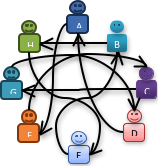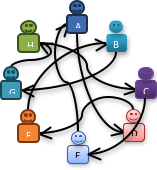Traditionally, the project manager or ScrumMaster is responsible for evaluating a team's performance. But peer feedback, when each member of a team picks another member, observes him or her, and then shares thoughts and suggestions about that other team member’s work, can also be very valuable to continuous improvement.
There are various team collaboration activities defined in the Scrum Guide, such as daily standups, sprint planning, and retrospectives. Scrum has built-in opportunities to inspect and adapt, especially when it comes to product feedback.
But personal feedback is also important. Traditionally, the project manager or ScrumMaster and the team leader are responsible for giving performance evaluations and sharing feedback with the team. This is usually in a one-to-many format, e.g., one reporting manager gives feedback to all subordinates at once. In a Scrum environment, the project manager or sometimes the ScrumMaster observes team member behavior and gives feedback, usually as part of a performance evaluation conducted with the team at the end of the year.
However, receiving feedback only from your superiors—and seldom, at that—can leave some gaps in adequate evaluations. This is where peer feedback can be useful.
What Is Peer Feedback?
Peer feedback is when each member of a team picks another member, observes him or her for a given time, and then shares thoughts and suggestions about that other team member’s job performance.
In terms of Scrum, the product owner and ScrumMaster can participate in peer feedback exercises, but their involvement needs to be done carefully. For example, the product owner might try to influence team members to accept nonprioritzed stories as an “improvement.” That’s not acceptable feedback. In that situation, a team member or someone such as the ScrumMaster needs to provide feedback to the product owner. In some cases, though, the product owner’s feedback can truly improve the team’s performance, so it is up to the team whether they want to try involving the product owner in peer feedback exercises.
Peer feedback functions well within the ideology that the Scrum team works closely together day to day to achieve sprint and release goals. Team members closely observe their peers’ behavior and individual contribution to a sprint’s success every day, so they tend to generate better, more meaningful evaluations for continuous improvement.
Methods for Delivering Peer Feedback
To kick off peer reviews on my team, we decided to each report two actions we liked about the peers we were reviewing and two areas where we thought our peers needed to improve in the next month. We used a lottery system for picking a peer, and we included the ScrumMaster. Repeated pairing with a peer or two peers evaluating each other was avoided.
There are several options for conducting a peer-feedback session, but a simple, common one is this four-step process.
- Pick a peer you want to evaluate.
- Observe his or her behavior for the specified period; the team may decide to make the duration in sync with their sprint length. However, everyone should be encouraged to share feedback at any time if someone is observed doing something that should be changed.
- Schedule a feedback session at the end of the specified period. If everyone is collocated, reserve a discussion room in advance for sharing evaluations face to face. Distributed teams can make use of a digital medium.
- Share feedback with your peer and record it, either on paper or digitally. Recording is crucial for future reference. You and the peer you evaluated should both understand and agree on the feedback and improvements suggested, and that should be recorded as well.
These pictures demonstrate two peer feedback cycles for the same team. As you can see, the people who were evaluated in the first round are doing the evaluating in the second round, and the pairings are all different.


Either a generic questionnaire or a specific, well-formatted feedback form should be fine. Or the team can start with open feedback and, after five or six rounds, switch to a more detailed questionnaire. EBay provides a good template for a peer feedback system and shares the success the company has had using it. But the most important factors in selecting a feedback format are that it should be simple and the team should agree on it.
When organizing your feedback, the Krauthammer Observatory recommends going by the acronym OSCAR:
I have observed (O) . . . particularly in this situation (S) . . . with the possible consequence (C). . . . I suggest the following alternative (A) . . . resulting in (R).
Conclusion
Peer feedback is a comparatively new concept in Scrum. It needs focused effort and, at times, a significant cultural change. In many organizations, especially large ones, the human resources department will have to play a large role in developing and encouraging a culture of peer feedback and making it a regular part of performance evaluations.
The whole objective is to practice continuous improvement. Retrospectives are a good way to realize where process and practice improvements are needed, and peer feedback can do the same for people and teams.


User Comments
Good one... Really help team to improve. let me try with my team.